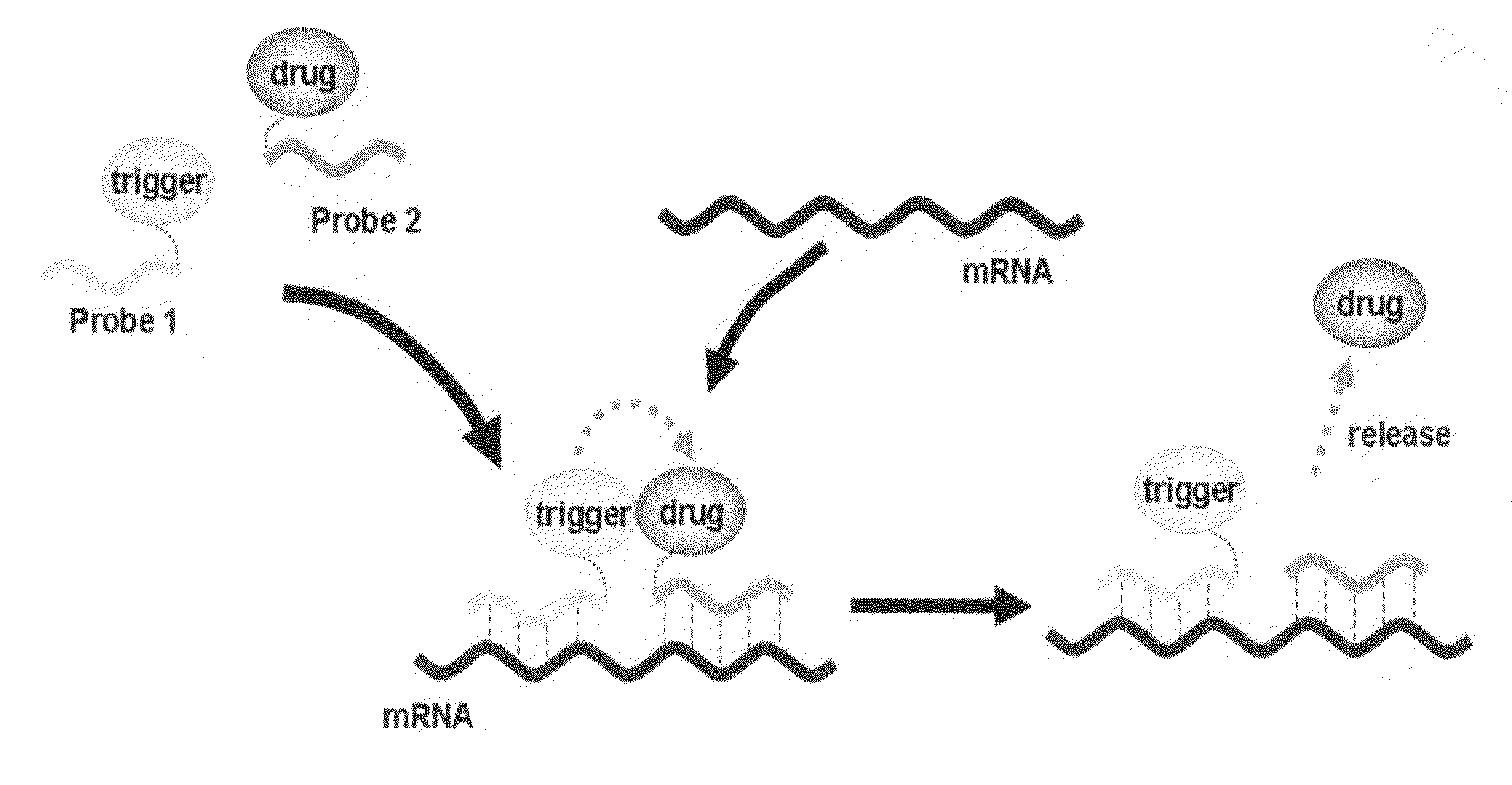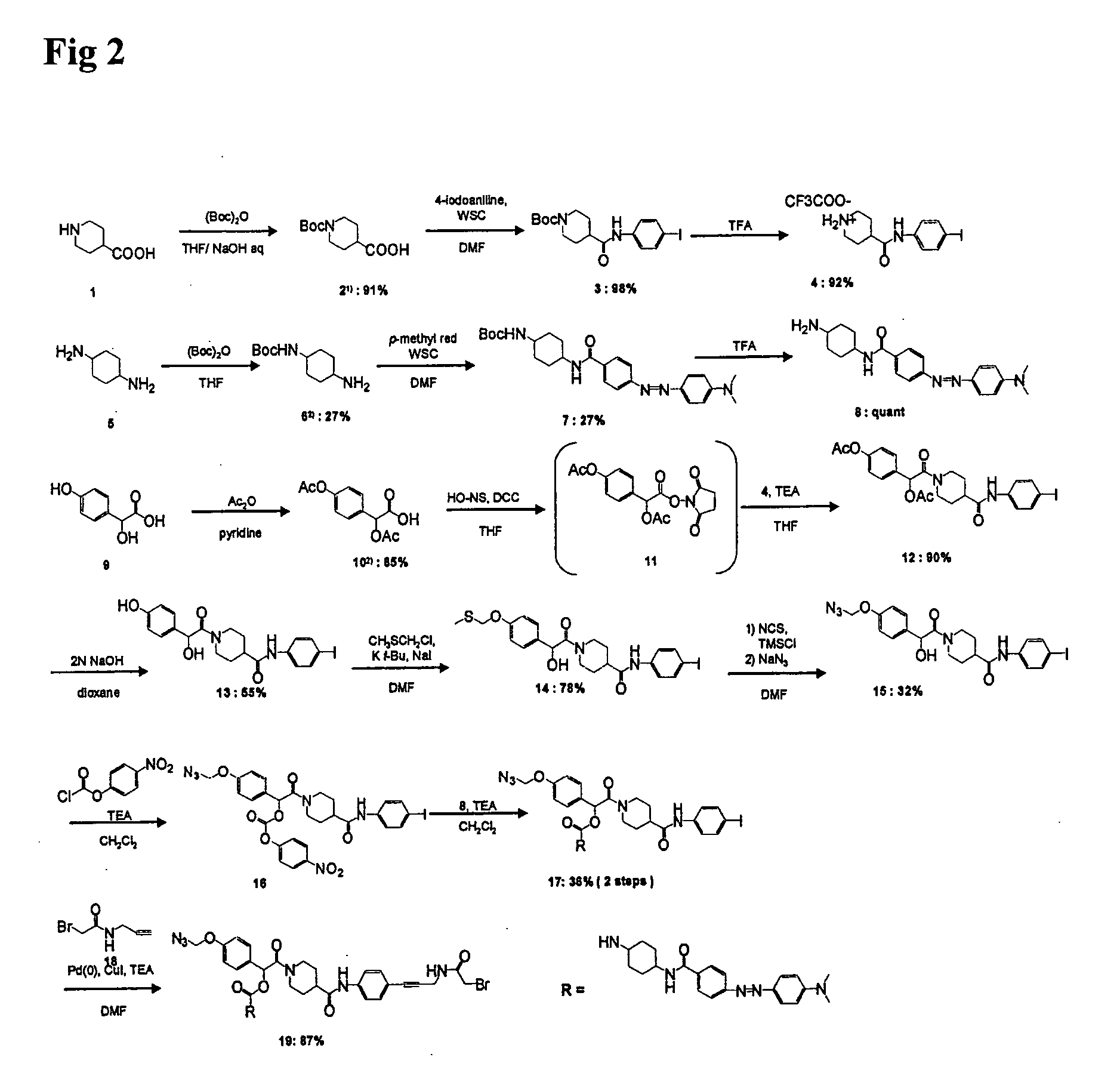Method for releasing molecule of interest based on target nucleic acid sequence
- Summary
- Abstract
- Description
- Claims
- Application Information
AI Technical Summary
Benefits of technology
Problems solved by technology
Method used
Image
Examples
example 1
Organic Synthesis of Compound of the Present Invention (Compound 19 Shown in FIG. 2)
(1) Synthesis of Compound 3 (Compound 3 Shown in FIG. 2)
[0095]Compound 1 (compound 1 shown in FIG. 2) was protected with Boc according to the method described in the publication of Alexopoulos et al. (K. Alexopoulos et al., (2001), J. Med. Chem., 44, 328-338), so as to obtain compound 2 (compound 2 shown in FIG. 2). Thereafter, compound 2 (2.2790 g; 9.9 mmol) and 4-iodoaniline (2.4156 g; 11.0 mmol; 1.1 eq) were dissolved in DMF (50 ml), and WSC (2.3130 g; 12.1 mmol; 1.2 eq) was then added to the solution. The mixture was stirred overnight. After the disappearance of compound 2 had been confirmed, the reaction solution was diluted with EtOAc. The resultant solution was separated with 2 N HCl (twice), and it was then washed with an NaCl saturated aqueous solution. The organic layer was dried over Na2SO4, and the residue was then purified with a silica gel column, so as to obtain compound 3 (4.1708 g; 9...
example 2
Synthesis of Oligonucleotides
[0141]All oligonucleotides were synthesized according to a common phosphoroamidite method using 0.2 μM-scale column, employing a DNA automatic synthesizer (H-8-SE; Gene World). Deprotection of nucleotides and cleavage thereof from a CPG carrier were carried out by incubation in ammonia water at 55° C. for 4 hours. Such oligonucleotide was purified using a reversed phase column (MicroPure II; Biosearch Technologies). The concentration was determined by measuring UV absorbance.
example 3
Production of DNA Probe to Which Compound of the Present Invention (Compound 19 Shown in FIG. 2) has Bound
[0142]Binding of compound 19 was carried out by reaction with 3′-phosphorothioate oligo. Such 3′-phosphorothioate oligo was synthesized by performing the coupling of 3′-phosphate CPG with an initial monomer and then converting the obtained product to 3′-phosphorothioate oligo using a sulfurizing reagent (Glen research). The reaction was carried out by intensively stirring a mixed solution comprising 3 mM compound 19 (in DMF), a 30-mM NaB buffer and a 300-μM 3′-phosphorothioate oligo solution at room temperature for 5 hours (DMF concentration in the reaction solution: 60%). Thereafter, the reaction solution was diluted with Milli Q, and it was then purified by reverse phase HPLC (gradient conditions: 0%-100% acetonitrile / 50 mM triethylammonium acetate). Moreover, it was confirmed by MALDI-TOF mass spectrometry that a product of interest was obtained. 5′-AAG FuTGCTT compound 19-3′...
PUM
| Property | Measurement | Unit |
|---|---|---|
| Structure | aaaaa | aaaaa |
| Fluorescence | aaaaa | aaaaa |
Abstract
Description
Claims
Application Information
 Login to View More
Login to View More - R&D
- Intellectual Property
- Life Sciences
- Materials
- Tech Scout
- Unparalleled Data Quality
- Higher Quality Content
- 60% Fewer Hallucinations
Browse by: Latest US Patents, China's latest patents, Technical Efficacy Thesaurus, Application Domain, Technology Topic, Popular Technical Reports.
© 2025 PatSnap. All rights reserved.Legal|Privacy policy|Modern Slavery Act Transparency Statement|Sitemap|About US| Contact US: help@patsnap.com



